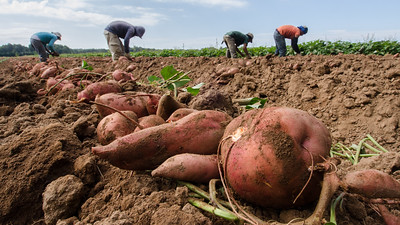Adequate nutrition is an indispensable element for human beings to live healthy lives. In a balanced diet, micronutrients, including vitamins and minerals, are required in low quantities yet have tremendous impacts on individuals’ mental and physical growth, especially children. Vitamin A is crucial in numerous biological phenomena and in regulating diverse bodily functions. Vitamin A deficiency is a paramount concern, especially for children and pregnant women in developing countries, as it may result in several health issues, such as stunting, infections, vision issues, and eye health.
Vitamin A supplementation can reduce vitamin A deficiency; however, this may turn out costly at high frequencies. A complementary initiative is to foster micronutrient-dense diets, such as the biofortification of staple crops. This may be a relevant approach as staple foods represent more than half of poor households’ calories. In that sense, orange-fleshed sweet potatoes (OFSP) are highly effective instrument for addressing vitamin A deficiency in children and women of reproductive age.
This food item can also contribute to mitigating the effect of climate change and exhibit strong abilities to withstand climate change events. Additionally, it could improve the livelihoods of manifold stakeholders in the agri-food system. Nevertheless, the uptake of this new food product requires the intervention of various stakeholders.
In October 2022, during the Bertebos Prize Seminar, Dr. Maria Isabel Andrade, International Potato Center (CIP), Mozambique, presented her successful work in implementing OFSP in Africa.
Orange-fleshed sweet potatoes, a large range of attributes for better health and incomes
Currently, white and yellow-fleshed sweet potatoes are the dominant variety in sub-Saharan Africa, which is problematic as they contain limited to no beta-carotene, a prerequisite of vitamin A. In contrast, OFSP is rich in beta-carotene. Rigorous biomedical research has evidenced that only 125 grams of most varieties of OFSP satisfy the daily vitamin A intake requirements of a preschool-aged child.
Moreover, this tuber crop lays out natural calamities’ robustness, such as drought and heat-tolerant, enhancing chances of successful production, although struck by climate change events. OFSP requires less water and labour inputs than most staple grains, a strong asset for resource-poor smallholder farmers, emphasised Maria Isabel Andrade.
The CIP and Maria Isabel Andrade highlighted that OFSP also appears to be a pertinent ingredient in the bakery industry through puree innovations, as it can substitute up to 60% of wheat flour. In addition to being healthier, this is also a considerable opportunity to reduce baking production costs and environmental impact through local supply since, for instance, in Kenya, approximately 80% of wheat is imported.
Therefore, OFSP holds significant potential to alleviate poverty among smallholder farmers and improve vulnerable populations’ food and nutrition security, especially in scaling down vitamin A deficiency.
Hence, important efforts to cultivate, promote awareness of and deliver adapted pro-vitamin A-rich OFSP emerged in sub-Saharan Africa during the past two decades.
As of now, over 6.8 million households in Africa and South Asia are breeding and eating vitamin A-rich OFSP. But how to further expand the production and consumption of this food item?
Bringing OFSP to mainstream
To broaden the cultivation of OFSP many initiatives have been launched such as the HarvestPlus Reaching End Users, or national sweet potato breeding programmes that have been rolled out in more than 20 countries in Africa and South Asia.
CIP and partners have utilised an integrated agriculture-marketing-nutrition approach grounded on partnerships, associating demand and supply side innovations to scale up the deliveries to farmers and consumers. Promotional campaigns and cooking classes are also crucial to integrating OFSP into local culinary systems and ensuring consumer acceptance. Maria Isabel Andrade explained that a lot of efforts were concentrated on marketing approaches to generate demand. As such, Maria Isabel Andrade’s working team implemented a community theatre in a village in Mozambique where they fed babies with OFSP, taught women how to cook this ingredient, and reached out to several radio programs to raise awareness of OFSP.

Ultimately, this will strengthen the demand and foster producers to engage in OFSP production, highlighted Maria Isabel Andrade. For instance, CIP established a platform for OFSP stakeholders to share ideas, information, and knowledge on the use of OFSP.
To disseminate knowledge and technology, the Consultative Group for International Agricultural Research (CGIAR) utilised gender-responsive communication materials in partnership with relevant actors, such as People In Need or CIP. Maria Isabel Andrade pointed out that they also taught food producers how to cultivate OFSP. A concrete example is the “Triple S” approach, accounting for “Storing in Sand and Sprouting”, which succeeded in ensuring a steady and natural supply of seeds for farmers and reducing production costs. This climate-smart method stores OFSP roots in the sand during dry months, allowing them to sprout and create planting materials. The planting materials are thereafter planted when the rainy season begins. Thus, this type of project offers great opportunities for a positive impact on food security, nutrition, and income.
Funding is also essential to develop OFSP since Maria Isabel Andrade underscored that funds enabled them to use digitalisation to bolster the yield, and pursue quality control of crops with drones, tablets, or barcodes.
In closing
OFSP, as rich in beta-carotene, can be a relevant means to curb the scourge of vitamin A deficiency in developing countries. This tuber crop can also contribute to smallholders’ food security via:
- Its low requirement in labour inputs and ability to grow under marginal conditions.
- Its high ratio of the amount of energy produced per unit of land and time.
- Its wide piecemeal harvesting period throughout the year.
The development of a new crop such as OFSP is a long process requiring the effort of multiple stakeholders to enable research, market insertion, utilisation, monitoring, learning and evaluation.
In a nutshell, multi-sectorial strategies merging agriculture with the education and health sector exhibit strong potential to reap exhaustive benefits of OFSP to transform food systems towards healthier, more sustainable, and resilient models.
Written by David Mingasson, SIANI reporter
